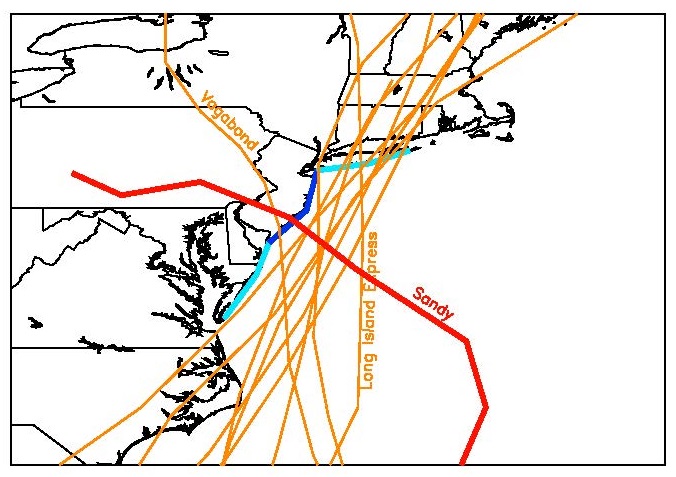3 June 2013
Hurricane Sandy took highly unusual path, but climate change doesn’t get the blame – yet

Unlike the 10 other hurricanes that made landfall in the region shown since 1851 and typically grazed the coast, Hurricane Sandy barreled into New Jersey on a path (red) nearly perpendicular to the shoreline. Figure from the paper. ©AGU.
By Sarah Charley
Hurricane Sandy’s peculiar path was exceedingly rare, but whether or not climate change influenced the trajectory remains unknown, new research suggests.
Sandy differed from most North Atlantic hurricanes by veering west over the northeastern United States and merging with a winter storm. But nothing proved more unusual about the “superstorm,” the authors of the study note, than the nearly perpendicular angle at which the storm approached the New Jersey shoreline and collided with the coast on October 29, 2012. Usually, hurricanes graze the coast rather than plunging into it head on.
In this new study, which evaluates how frequently hurricanes with near-perpendicular tracks should impact the U.S. East Coast, Timothy Hall of the NASA Goddard Institute for Space Studies and Adam Sobel of Columbia University, both in New York City, ran statistical simulations of millions of Atlantic hurricanes—the equivalent of 50,000 years’ worth of the storms—under conditions representing the average regional climate between 1950 and 2010.
Sandy’s remarkable perpendicularity fueled the storm’s fury, Hall notes. “When storms graze the coast, they don’t have as much time to build up large amounts of water,” he said. “But when they hit dead on, they can move a lot of water and increase the height of the storm surge, causing extensive flooding like Sandy did.”
But that near-perpendicular path also made Sandy a highly unlikely occurrence under late 20th – early 21st century climate conditions, the authors found. A hurricane with a track resembling Sandy’s is likely to occur on average only once in about 700 years, their simulations showed. The researchers had to simulate vast numbers of “synthetic tropical cyclones” in order to produce enough of the rare few that hit the coast almost perpendicularly to come up with a meaningful time scale for the interval between such storms.
In a historical record dating back to 1851 that the team consulted, no other hurricane of equal or greater strength had hit land at an angle anywhere near as perpendicular as Sandy, whose path was off by just 17 degrees from making a right angle with the coast.
Hall and Sobel report their findings in a paper published last week (29 May 2013) in Geophysical Research Letters, a journal of the American Geophysical Union. Their results agree with two other studies that predicted hurricanes would impact Manhattan with Sandy’s 9-foot surge or greater once every 400-800 years. “We had completely different models and were looking at different things, but our results overlapped,” Hall said. “This points to a very unusual storm.”
Despite speculation that Sandy was the result of climate change, Hall stresses that as of right now, it is impossible to know. “This is a baseline estimate for how rare an event like this is, given steady-state climate,” Hall said. “If we see an increase in frequency, then we know changes in the climate are changing the probability.”
It’s like rolling dice, Hall said, except if climate change is having an influence, they’re loaded dice: “If one year you get a six, it’s impossible to know whether that six was the result of random chance or something else” he explained. “But if you keep getting sixes, you know the dice are weighted.”
Typically, North Atlantic hurricanes are pushed eastward by the jet stream as they approach higher latitudes, Hall said. However, the year Sandy occurred, a meander in the jet stream diminished this effect. Some scientists speculate that climate change is weakening the jet stream and increasing its tendency to meander, but Hall contends that it’s too soon to tell.
“There are some theories that melting sea ice affects the jet stream, but there are other models that show the opposite,” Hall said. “We don’t really know yet.”
If Sandy’s path was an anomaly and not a product of climate change, the planet’s warming nonetheless contributed to the damage Sandy inflicted on coastal communities, according to Hall. The combination of Sandy’s storm surge plus high tides raised water levels to a 14-foot peak at Battery Park in southern Manhattan. “In the past 100 years, mean sea level at the Battery has increased by roughly one foot,” noted Hall. “So, one foot out of 14 was due to sea-level increase.”
— Sarah Charley reported and wrote this post while working as AGU’s Spring 2013 science writing intern.



 GeoSpace is a blog on Earth and space science, managed by AGU’s Public Information staff. The blog features posts by AGU writers and guest contributors on all sorts of relevant science topics, but with a focus on new research and geo and space sciences-related stories that are currently in the news.
GeoSpace is a blog on Earth and space science, managed by AGU’s Public Information staff. The blog features posts by AGU writers and guest contributors on all sorts of relevant science topics, but with a focus on new research and geo and space sciences-related stories that are currently in the news.